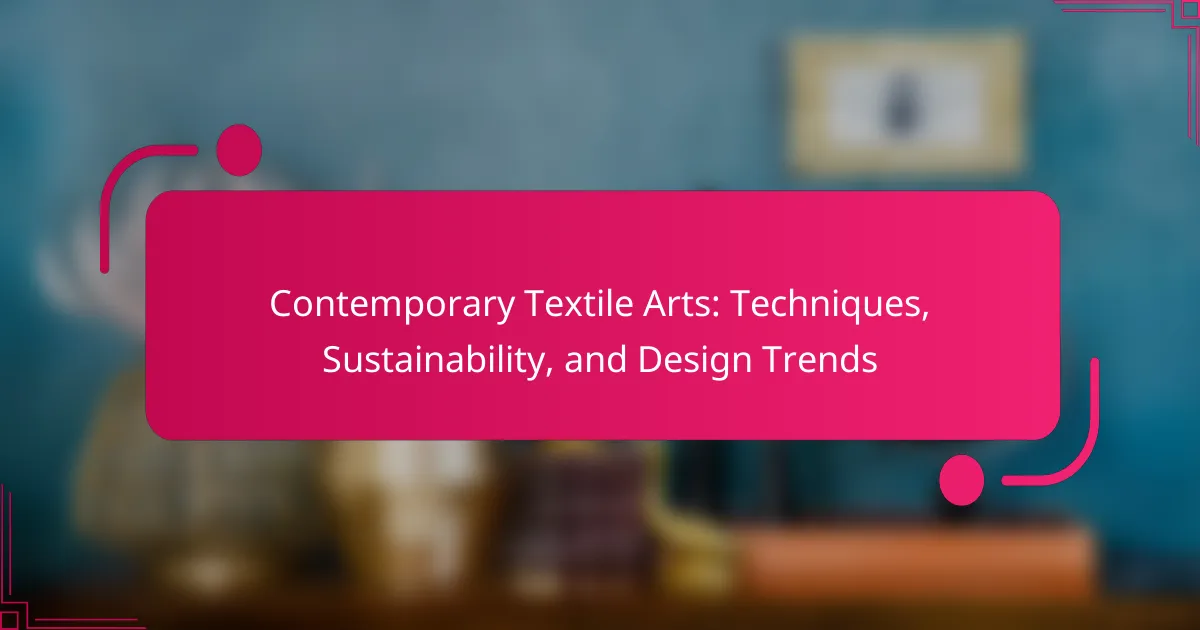Contemporary textile arts emphasize creativity and sustainability while addressing the challenges artists face. This article explores various techniques like digital printing and eco-friendly dyeing, highlights the importance of sustainable practices, and examines current design trends that blend tradition with modern aesthetics. Regional influences on textile arts and the impact of market competition are also discussed, providing a comprehensive view of this evolving field.
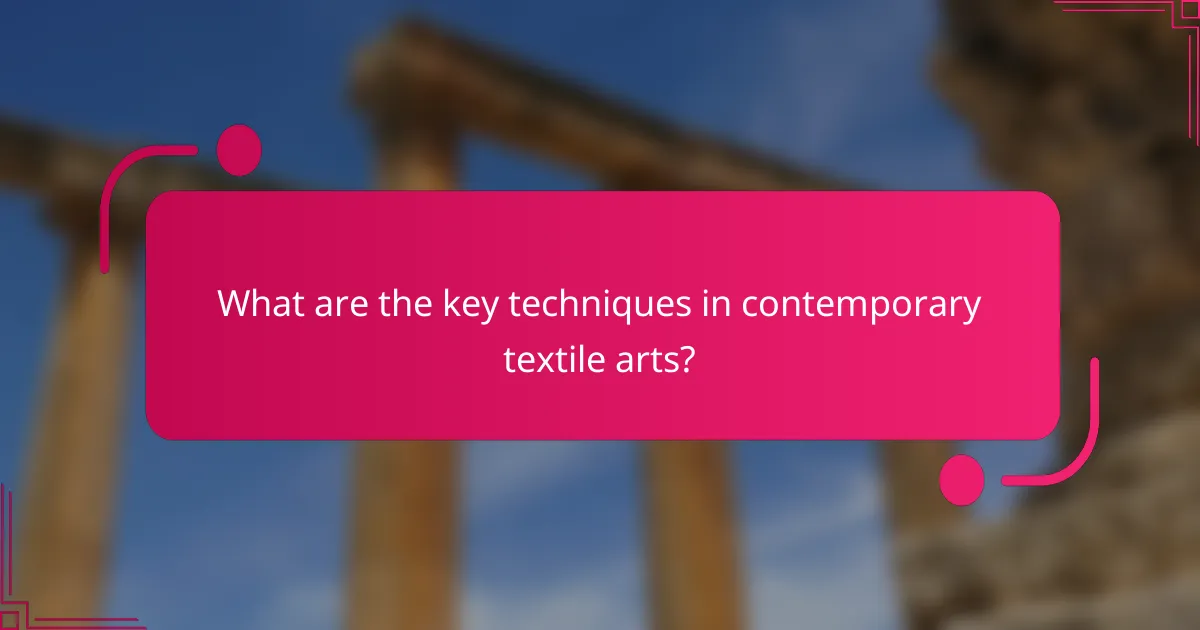
What are the key techniques in contemporary textile arts?
Contemporary textile arts utilize various techniques that emphasize creativity, sustainability, and innovation. Key techniques include digital printing, which allows intricate designs, and eco-friendly dyeing methods that reduce environmental impact. Hand weaving remains significant for its unique textures, while upcycling transforms discarded materials into new art forms. Additionally, embroidery and quilting are experiencing a resurgence, merging traditional craftsmanship with modern aesthetics.
How do traditional methods influence modern practices?
Traditional methods significantly shape modern textile arts by integrating time-honoured techniques into contemporary practices. These methods emphasize craftsmanship, sustainability, and cultural heritage, influencing design trends and material choices. For example, hand-weaving and natural dyeing techniques are increasingly valued for their environmental benefits and unique aesthetics. As a result, modern designers often blend traditional skills with innovative technologies, creating textiles that honour the past while meeting current demands. This fusion enhances the appeal of contemporary textile arts, making them more relevant in today’s sustainable fashion landscape.
Which innovative techniques are emerging in 2025?
Innovative techniques in contemporary textile arts for 2025 include digital weaving, biofabrication, and smart textiles. These methods enhance sustainability and design flexibility. Digital weaving allows for intricate patterns with minimal waste. Biofabrication utilizes organic materials to create textiles, promoting eco-friendly practices. Smart textiles incorporate technology for functionality, such as temperature regulation and moisture control. Each technique reflects a commitment to innovation and sustainability in design.
What role does digital technology play in textile creation?
Digital technology significantly enhances textile creation by improving design precision and enabling sustainable practices. Techniques such as 3D printing and digital weaving allow for intricate patterns and reduced waste. Additionally, software tools streamline the design process, fostering innovation in contemporary textile arts. As a result, designers can experiment with new materials and methods, pushing the boundaries of traditional textile production.
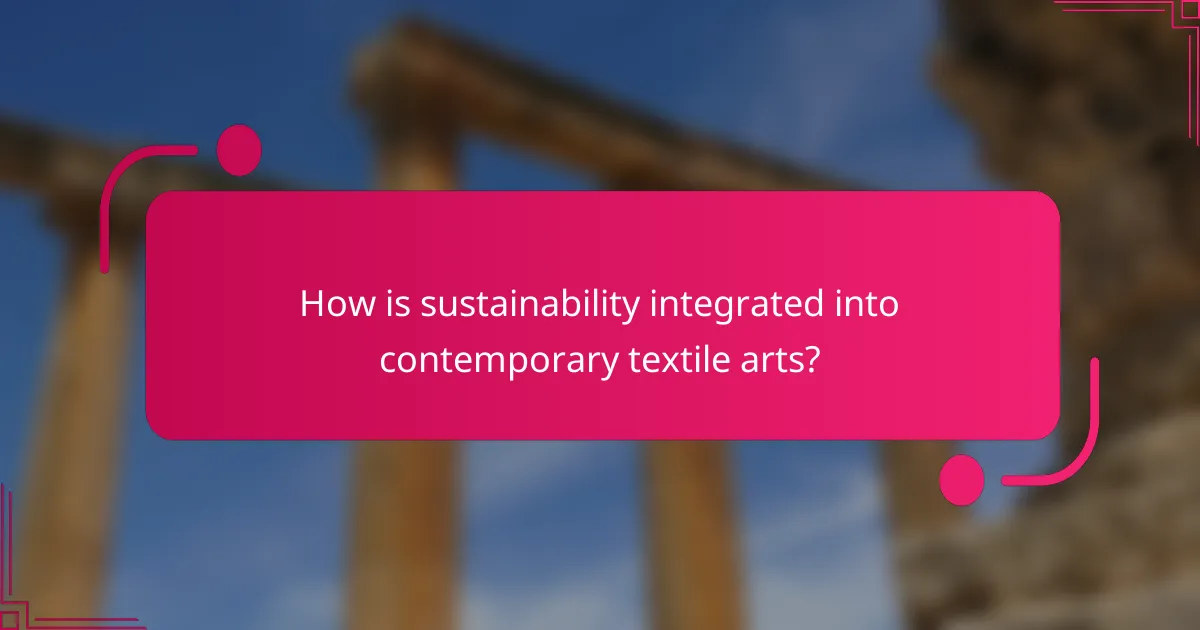
How is sustainability integrated into contemporary textile arts?
Sustainability is integrated into contemporary textile arts through eco-friendly materials, innovative techniques, and ethical production practices. Artists prioritize natural fibres, recycled materials, and low-impact dyes to reduce environmental harm. Techniques like upcycling and hand-weaving promote sustainability by minimizing waste and energy consumption. Design trends emphasize minimalism and functionality, reflecting a commitment to responsible consumption. This shift not only enhances the aesthetic value but also fosters a deeper connection between the artisan and the environment.
What are the environmental impacts of textile production?
Textile production significantly impacts the environment through pollution, resource depletion, and waste generation. The process involves high water usage, chemical runoff, and greenhouse gas emissions. For instance, conventional cotton farming requires about 7,000 litres of water per kilogram of cotton produced. Additionally, synthetic fibres contribute to microplastic pollution in oceans. Sustainable practices, such as organic farming and recycling, can mitigate these effects, promoting a more eco-friendly textile industry.
Which sustainable materials are gaining popularity?
Sustainable materials gaining popularity include organic cotton, hemp, Tencel, recycled polyester, and bamboo. These materials are favoured for their lower environmental impact and biodegradability. Organic cotton uses no synthetic pesticides, while hemp requires less water. Tencel is produced from sustainably sourced wood pulp, and recycled polyester reduces plastic waste. Bamboo grows rapidly, making it a renewable resource.
How can artists reduce waste in their practices?
Artists can reduce waste in their practices by adopting sustainable techniques and materials. Utilizing recycled textiles minimizes environmental impact. Implementing zero-waste design principles ensures every piece of fabric is used efficiently. Collaborating with local artisans promotes resource sharing, reducing excess materials. Engaging in community swaps allows artists to exchange unused supplies, fostering a circular economy. Additionally, digital design tools can help visualize projects before production, cutting down on waste from trial and error.

What are the current design trends in textile arts?
Current design trends in textile arts emphasize sustainability, innovative techniques, and a blend of traditional and modern aesthetics. Key trends include the use of eco-friendly materials, digital printing technologies, and a focus on handcrafted details. Designers are increasingly integrating sustainable practices, such as upcycling and natural dyes, to reduce environmental impact. Additionally, there is a growing interest in textile art that tells a story, reflecting cultural heritage and personal narratives.
Which colour palettes are trending in 2025?
In 2025, trending colour palettes in contemporary textile arts feature earthy tones, vibrant jewel shades, and soft pastels. These palettes emphasize sustainability and reflect a growing preference for natural aesthetics. Earthy tones like terracotta and olive green promote a connection to nature. Vibrant jewel shades, including emerald and sapphire, add richness and depth. Soft pastels, such as blush and mint, create a calm and inviting atmosphere. These colour trends align with the increasing demand for sustainable and mindful design in textile arts.
How are cultural influences shaping textile designs?
Cultural influences significantly shape textile designs by integrating traditional motifs, sustainable practices, and contemporary aesthetics. Globalization allows for cross-cultural exchanges, enhancing creativity in textile arts.
For instance, indigenous patterns often inspire modern designers, merging cultural heritage with innovative techniques. Sustainability drives the use of eco-friendly materials, reflecting cultural values of environmental stewardship.
Regional styles also influence colour palettes and fabric choices, showcasing local resources and craftsmanship. This blend of tradition and modernity creates unique textile identities that resonate globally.
What role does functionality play in contemporary textile design?
Functionality is crucial in contemporary textile design as it enhances usability and aesthetic appeal. Designers integrate practical features, such as durability and ease of maintenance, while also considering sustainability. This dual focus on function and form reflects current trends where textiles serve both decorative and practical purposes. For example, smart textiles incorporate technology to improve user experience, showcasing an innovative blend of functionality and design.
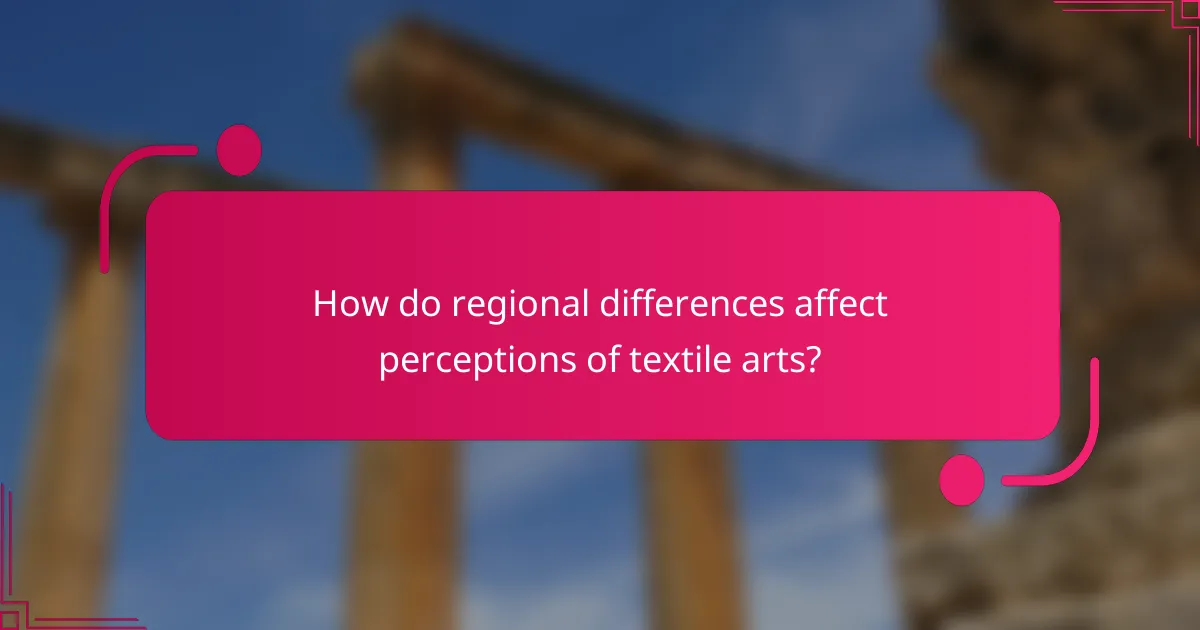
How do regional differences affect perceptions of textile arts?
Regional differences significantly shape perceptions of textile arts through cultural heritage, available materials, and local techniques. For instance, in Japan, traditional weaving methods emphasize precision and craftsmanship, while in West Africa, vibrant colours and patterns reflect community identity. These unique attributes influence design trends and sustainability practices in each region. Furthermore, the global dialogue on textile arts encourages cross-cultural exchanges, enriching contemporary practices and promoting awareness of environmental impacts. As a result, regional contexts not only define artistic expressions but also drive innovation in sustainable textile production.
What are the unique attributes of textile arts in different cultures?
Textile arts in different cultures exhibit unique attributes that reflect their distinct histories and values. For example, Japanese textiles emphasize intricate patterns and natural dyes, showcasing a commitment to craftsmanship. In contrast, African textiles often feature bold colours and geometric designs, representing cultural identity and storytelling. Indigenous American textiles utilize traditional weaving techniques, highlighting communal practices and spiritual significance. These unique attributes contribute to the richness of contemporary textile arts, influencing design trends and sustainability practices across cultures.
Which local events and exhibitions are notable in the textile community?
Notable local events and exhibitions in the textile community include the Textile Arts Festival, the Sustainable Fabric Fair, and the Contemporary Textile Design Showcase. These events highlight innovative techniques, sustainable practices, and current design trends in contemporary textile arts. They provide platforms for artists and designers to present their work and engage with the community.
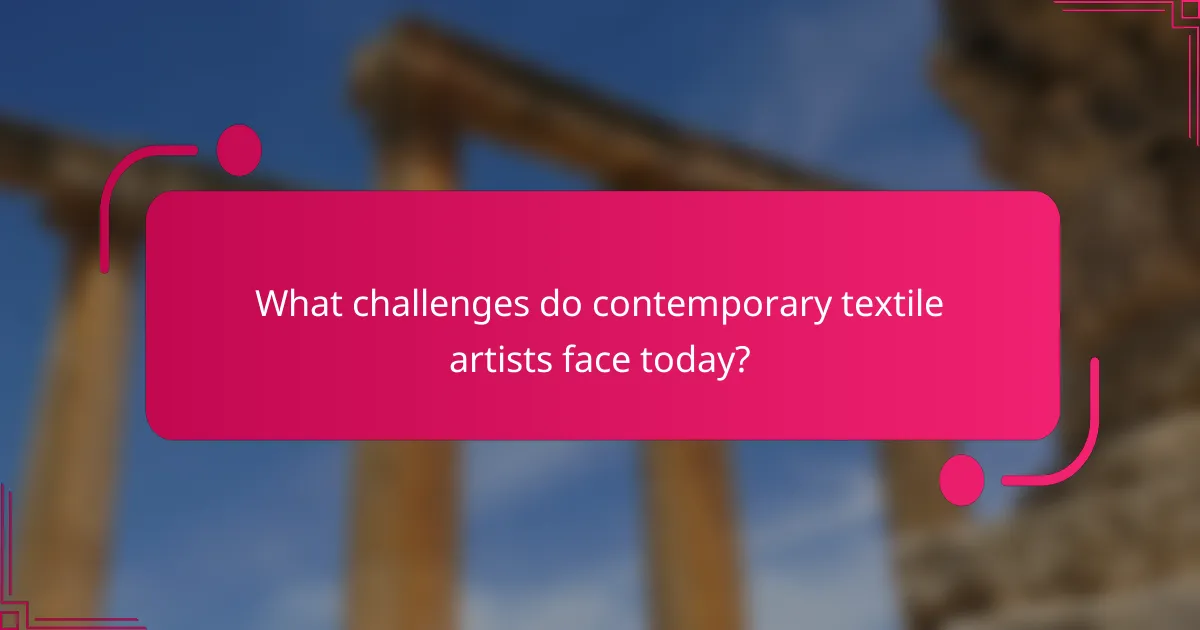
What challenges do contemporary textile artists face today?
Contemporary textile artists face challenges such as sustainability, technological integration, and market competition. Sustainability concerns drive the need for eco-friendly materials and practices. Artists must adapt to digital tools and techniques, which can enhance creativity but also require new skills. Competition in the art market pressures artists to differentiate their work. Additionally, economic factors can limit access to resources and funding for projects.
How does market demand impact artistic expression?
Market demand significantly influences artistic expression in contemporary textile arts. Artists adapt their techniques and designs to align with consumer preferences, sustainability trends, and market viability. For instance, emerging interest in eco-friendly materials drives innovation in sustainable practices, reshaping traditional methods.
As a result, textile artists often blend contemporary aesthetics with sustainable attributes, creating unique pieces that resonate with environmentally conscious consumers. This fusion of art and market demand fosters a dynamic creative landscape where innovation thrives.
The interplay between demand and artistic expression also highlights the importance of cultural relevance. Artists draw inspiration from societal trends, ensuring their work remains pertinent and impactful. This responsiveness not only enhances artistic value but also expands market reach.
Ultimately, the relationship between market demand and artistic expression shapes the future of contemporary textile arts, encouraging a balance between creativity and commercial viability.
What are common misconceptions about textile arts?
Many misconceptions exist about contemporary textile arts. Some believe it lacks innovation, while others think it is solely about traditional techniques. In reality, contemporary textile arts incorporate modern technologies and sustainable practices. Additionally, many assume that textile arts are not relevant in high fashion, but they play a significant role in current design trends. Another misconception is that textile arts are only for women, overlooking the contributions of diverse artists across genders.

What best practices should contemporary textile artists follow?
Contemporary textile artists should prioritize sustainability, innovative techniques, and current design trends. Embracing eco-friendly materials reduces environmental impact. Experimenting with digital tools enhances creativity and efficiency. Following trends like upcycling and minimalism keeps work relevant. Networking with other artists fosters collaboration and growth.
How can artists effectively market their textile creations?
Artists can effectively market their textile creations by leveraging social media, participating in craft fairs, and collaborating with local boutiques. Building a strong online presence through platforms like Instagram showcases their work and engages potential customers. Craft fairs provide direct access to audiences, allowing artists to connect personally and receive immediate feedback. Collaborating with boutiques enhances visibility and can lead to new customer bases. Additionally, using sustainable materials can attract eco-conscious consumers and differentiate their brand in a competitive market.
What resources are available for ongoing education in textile arts?
Numerous resources support ongoing education in contemporary textile arts. Online platforms offer courses on techniques, sustainability, and design trends. Community colleges and universities provide degree programs and workshops. Local art centres often host classes and events. Professional organizations publish journals and host conferences for networking and knowledge sharing. Additionally, social media groups and forums facilitate peer learning and collaboration.
What common mistakes should artists avoid in their practices?
Artists should avoid common mistakes that hinder their growth and creativity. Focusing too much on trends rather than personal expression can dilute authenticity. Neglecting sustainable practices can lead to environmental harm. Additionally, failing to experiment with techniques limits innovation. Lastly, not seeking constructive feedback may prevent artistic development.
